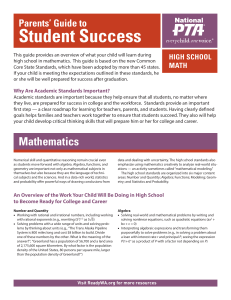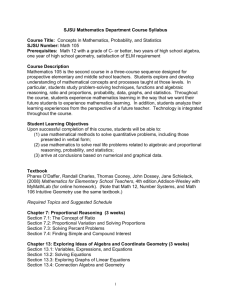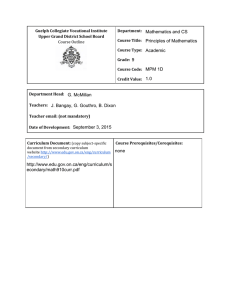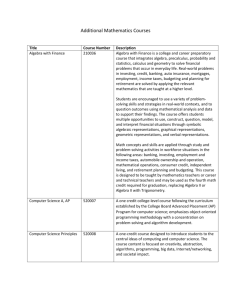Student Success PARENTS’ GUIDE TO HIGH SCHOOL MATH
advertisement
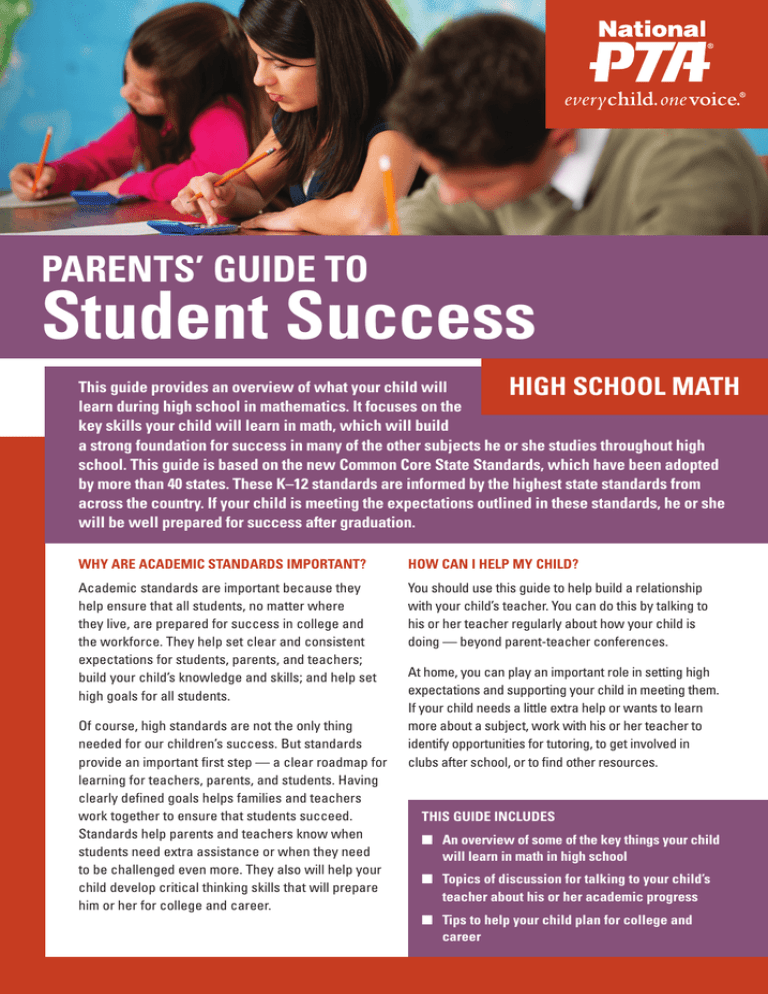
PARENTS’ GUIDE TO Student Success HIGH SCHOOL MATH This guide provides an overview of what your child will learn during high school in mathematics. It focuses on the key skills your child will learn in math, which will build a strong foundation for success in many of the other subjects he or she studies throughout high school. This guide is based on the new Common Core State Standards, which have been adopted by more than 40 states. These K–12 standards are informed by the highest state standards from across the country. If your child is meeting the expectations outlined in these standards, he or she will be well prepared for success after graduation. WHY ARE ACADEMIC STANDARDS IMPORTANT? HOW CAN I HELP MY CHILD? Academic standards are important because they help ensure that all students, no matter where they live, are prepared for success in college and the workforce. They help set clear and consistent expectations for students, parents, and teachers; build your child’s knowledge and skills; and help set high goals for all students. You should use this guide to help build a relationship with your child’s teacher. You can do this by talking to his or her teacher regularly about how your child is doing — beyond parent-teacher conferences. Of course, high standards are not the only thing needed for our children’s success. But standards provide an important first step — a clear roadmap for learning for teachers, parents, and students. Having clearly defined goals helps families and teachers work together to ensure that students succeed. Standards help parents and teachers know when students need extra assistance or when they need to be challenged even more. They also will help your child develop critical thinking skills that will prepare him or her for college and career. At home, you can play an important role in setting high expectations and supporting your child in meeting them. If your child needs a little extra help or wants to learn more about a subject, work with his or her teacher to identify opportunities for tutoring, to get involved in clubs after school, or to find other resources. THIS GUIDE INCLUDES ■ An overview of some of the key things your child will learn in math in high school ■ Topics of discussion for talking to your child’s teacher about his or her academic progress ■ Tips to help your child plan for college and career Mathematics To prepare for college and career, your child will study mathematics across a broad spectrum, from pure mathematics to real-world applications. Numerical skill and quantitative reasoning remain crucial even as students move forward with algebra. Algebra, functions, and geometry are important not only as mathematical subjects in themselves but also because they are the language of technical subjects and the sciences. And in a data-rich world, statistics and probability offer powerful ways of drawing conclusions from data and dealing with uncertainty. The high school standards also emphasize using mathematics creatively to analyze real-world situations — an activity sometimes called “mathematical modeling.” The high school standards are organized into six major content areas: Number and Quantity; Algebra; Functions; Modeling; Geometry; and Statistics and Probability. A Sample of the Work Your Child Will Be Doing To Become Ready for College and Career NUMBER AND QUANTITY ALGEBRA ■ Working with rational and irrational numbers, including working with rational exponents (e.g., rewriting (53)1/2 as 5√5) ■ Solving real-world and mathematical problems by writing and solving nonlinear equations, such as quadratic equations (ax2 + bx + c = 0) ■ Solving problems with a wide range of units and solving problems by thinking about units (e.g., “The Trans Alaska Pipeline System is 800 miles long and cost $8 billion to build. Divide one of these numbers by the other. What is the meaning of the answer?”; “Greenland has a population of 56,700 and a land area of 2,175,600 square kilometers. By what factor is the population density of the United States, 80 persons per square mile, larger than the population density of Greenland?”) ■ Interpreting algebraic expressions and transforming them purposefully to solve problems (e.g., in solving a problem about a loan with interest rate r and principal P, seeing the expression P(1+r)n as a product of P with a factor not depending on P) FUNCTIONS ■ Analyzing functions algebraically and graphically, and working with functions presented in different forms (e.g., given a graph of one quadratic function and an algebraic expression for another, say which has the larger maximum) ■ Working with function families and understanding their behavior (such as linear, quadratic, and exponential functions) MODELING ■ Analyzing real-world situations using mathematics to understand the situation better and optimize, troubleshoot, or make an informed decision (e.g., estimating water and food needs in a disaster area, or using volume formulas and graphs to find an optimal size for an industrial package) GEOMETRY ■ Proving theorems about triangles and other figures (e.g., that the angles in a triangle add to 180º) ■ Solving applied problems involving trigonometry of right triangles ■ Using coordinates and equations to describe geometric properties algebraically (e.g., writing the equation for a circle in the plane with specified center and radius) STATISTICS AND PROBABILITY ■ Making inferences and justifying conclusions from sample surveys, experiments, and observational studies ■ Working with probability and using ideas from probability in everyday situations (e.g., comparing the chance that a person who smokes will develop lung cancer to the chance that a person who develops lung cancer smokes) Keeping the conversation focused. When you talk to the teacher, do not worry about covering everything. Instead, keep the conversation focused on the most important topics. In high school, these include: ■ Does my child have a strong grounding in arithmetic, including operations on fractions, decimals, and negative numbers? Talking to Your Child’s Teacher ■ Does my child take a thinking approach to algebra and work with algebraic symbols fluently? ■ Is my child comfortable using coordinates in algebra and geometry? ■ Can my child break a complex problem down into parts and apply the math he or she knows to problems outside of mathematics? ■ Does my child use terms precisely and make logical arguments? ■ Does my child have the knowledge to learn advanced mathematics after high school if he or she so chooses? Ask to see a sample of your child’s work. Ask the teacher questions such as: Is this piece of work satisfactory? How could it be better? Is my child on track? How can I help my child improve or excel in this area? If my child needs extra support or wants to learn more about a subject, are there resources to help his or her learning outside the classroom? PTA.org PARENT TIPS Planning for College and Career At the beginning of high school, sit down with your child’s teachers, counselor, or other advisor to discuss what it will take for your child to graduate, your child’s goals, and his or her plans after high school. Create a plan together to help your child reach these goals, and review it every year to make sure he or she is on track. This plan should include: ■ An appropriate course sequence to meet your child’s goals. For example, if your child wants to study biosciences in college, he or she will likely need additional or advanced math and science courses in high school to be prepared for college-level coursework. ■ The most appropriate extracurricular activities for your child to participate in. For example, if your child is interested in journalism or photography, encourage him or her to sign up for the school newspaper or yearbook. These activities will help your child expand his or her learning outside of school and may help foster new hobbies or interests. ■ Ways you can help your child prepare for college or career. For example, if your child is interested in a particular field, look to see if internships exist to build his or her work experience in that subject area. Look for college fairs to attend, and encourage your child to visit colleges he or she might be interested in. ■ Finding ways to pay for college or advanced training. College can be expensive, but there are lots of ways to get financial help, such as scholarships, grants, work study programs, and student loans. You just need to make the time for you and your child to do the research. You can start by helping your child fill out the FAFSA (Free Application for Federal Student Aid) during his or her senior year of high school. Visit www.fafsa.ed.gov for help and more information on FAFSA and financial aid. For more information, the full standards are available at www.corestandards.org. National PTA 1250 N Pitt Street Alexandria,VA 22314 Toll-Free: (800) 307-4PTA (4782) PTA.org • info@pta.org © 2011 PTA All rights reserved. Printed in U.S.A. (1/11) and everychild.onevoice.® are registered service marks of the National Congress of Parents and Teachers.
